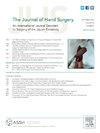基于计算机的交互式手术知情同意书对决策冲突的影响。
IF 2.1
2区 医学
Q2 ORTHOPEDICS
引用次数: 0
摘要
目的:手术知情同意书既能解决医疗护理的法律问题,又能做到简单、信息丰富和感同身受。我们开发了交互式知情同意书,并将其与标准印刷版知情同意书进行比较,询问:(1) 是否有任何因素(包括同意书格式)与较低的决策冲突或较高的患者评价临床医生移情相关?(2) 是否有任何因素(包括同意书格式)与同意过程的信息量、舒适度和满意度评分相关?九十四名成年患者接受了三名手外科医生之一的手术提议,以解决六种常见手部手术诊断中的一种:腕管松解术、肘管松解术、扳机指松解术、桡骨远端骨折钢板和螺钉固定术、良性肿块(包括神经节囊肿)切除术和杜普伊特伦挛缩松解术。53名患者随机填写了互动同意书,41名患者填写了标准书面同意书。对焦虑、抑郁和无助想法等症状进行了测量。患者完成了决策冲突量表和杰斐逊患者对医生移情感知量表,并对同意书的信息量、舒适度和满意度进行了0-10分的评分:结果:更大的决策冲突与患者对症状的更多无益想法略有关联,但与同意书的格式无关。对同意过程的舒适度评分越高,患者选择手术治疗的可能性越大,但与同意书的格式无关。考虑到多变量分析中可能存在的混杂因素,同意过程信息量越大,患者越倾向于手术治疗,而不是非手术治疗:互动式同意书与决策冲突或患者体验的其他方面无关,这一观察结果表明,相对于患者与临床医生之间的互动,此类工具可能并不重要:临床相关性:改善知情同意的工作可能需要关注患者与外科医生之间的对话,而不是信息的呈现方式。本文章由计算机程序翻译,如有差异,请以英文原文为准。
The Impact of a Computer-Based Interactive Informed Consent for Surgery on Decision Conflict
Purpose
Informed consent for surgery can address the legal aspects of care while also being simple, informative, and empathic. We developed interactive informed consents and compared them with standard printed informed consents asking: (1) are there any factors associated with lower decision conflict or greater patient-rated clinician empathy including consent format? (2) Are there any factors associated with rating the consent process as informative, comfortable, and satisfying including consent format?
Methods
Ninety-four adult patients accepted an offer of surgery from one of three hand surgeons to address one of six common hand surgery diagnoses: carpal tunnel release, cubital tunnel release, trigger finger release, plate and screw fixation of a distal radius fracture, removal of a benign mass, including a ganglion cyst, and Dupuytren contracture release. Fifty-three patients were randomized to complete an interactive consent, and 41, a standard written consent. Symptoms of anxiety, depression, and unhelpful thoughts were measured. Patients completed the Decision Conflict Scale and the Jefferson Scale of Patient’s Perceptions of Physician Empathy and rated the consent as informative, comfortable, and satisfactory on a scale of 0–10.
Results
Greater decisional conflict was slightly associated with greater patient unhelpful thoughts about symptoms and was not associated with consent format. A higher rating of comfort with the consent process was slightly associated with patient choice to proceed with surgical treatment, but not with consent format. Accounting for potential confounding in multivariable analysis, a higher rating of the consent process as informative was slightly associated with patient preference for surgical over nonsurgical treatment,
Conclusions
The observation that an interactive consent form was not related to decision conflict or other aspects of patient experience suggests that such tools may not have much weight relative to the interaction between patient and clinician.
Clinical relevance
Efforts to improve informed consent may need to focus on the dialog between patient and surgeon rather than how information is presented.
求助全文
通过发布文献求助,成功后即可免费获取论文全文。
去求助
来源期刊
CiteScore
3.20
自引率
10.50%
发文量
402
审稿时长
12 weeks
期刊介绍:
The Journal of Hand Surgery publishes original, peer-reviewed articles related to the pathophysiology, diagnosis, and treatment of diseases and conditions of the upper extremity; these include both clinical and basic science studies, along with case reports. Special features include Review Articles (including Current Concepts and The Hand Surgery Landscape), Reviews of Books and Media, and Letters to the Editor.

 求助内容:
求助内容: 应助结果提醒方式:
应助结果提醒方式:


